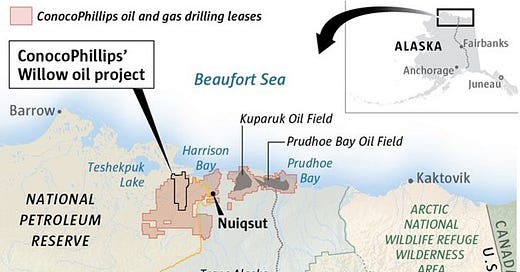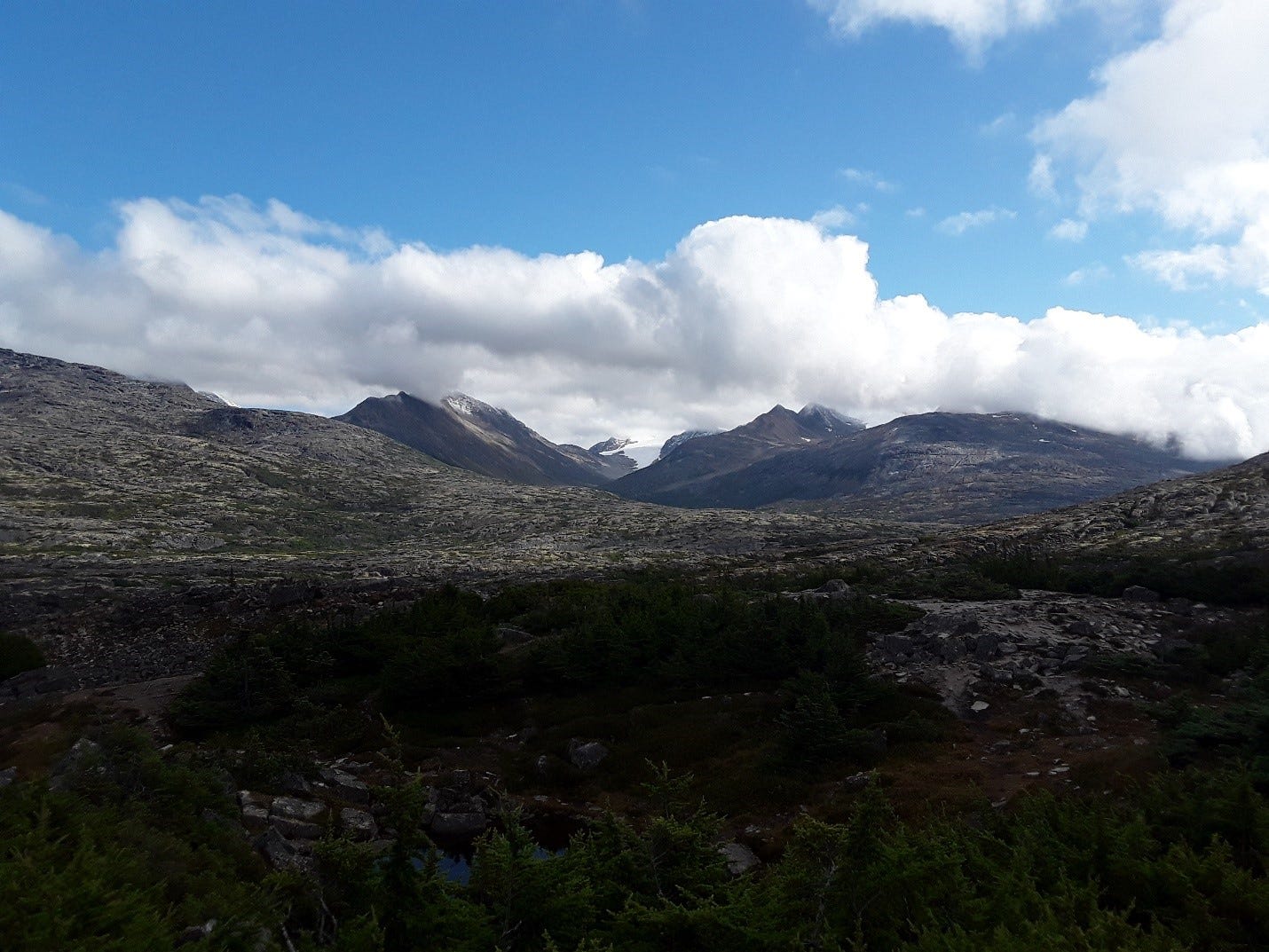[Yesterday, 6th September 2023, the President Biden administration announced that it would cancel the Trump-era drilling leases in Alaska’s Arctic National Wildlife Refuge. It also announced that it would prohibit drilling in the 13 million acres of the National Petroleum Reserve. The term U-turn tends not to be used in American politics, but it seems President Biden has just done such a thing.]
Here is a repost of an article I published in March this year.]
Two areas of the Alaskan North Slope have been in the news in recent weeks:
· The Willow Project in the National Petroleum Reserve, in the NW of Alaska, to the west of the Trans-Alaska Pipeline and Prudhoe Bay
· The Arctic National Wildlife Refuge (ANWR) wilderness area, in the NE of Alaska, to the east of the Trans-Alaska Pipeline and Prudhoe Bay.
The Willow Project
In March 2023, President Biden approved the Conoco Phillips Willow oil project on the National Petroleum Reserve. Some leaders of Alaskan First Nation villages and some bipartisan political leaders believe the three sites approved (originally five were proposed) will provide an economic boost for indigenous communities in the region with thousands of jobs being created. However, many environmentalists and some other indigenous groups have criticised the decision. Many of the latter state that the decision undermines the President’s goals to act against climate change.
The project is expected to yield up to 180,000 barrels of oil a day, which will account for 1.5% of total US oil production. The total yield is estimated to be over 570 million barrels, and the field will be in production for over 30 years. According to US Bureau of Land Management estimates, this means the project will generate up to 278 million metric tonnes of CO2e over its 30-year lifetime - the equivalent of adding two million cars to US roads every year. [CO2e is a unit used to express the climate impact of all greenhouse gases together, as if they were all emitted as carbon dioxide.]
As part of the deal, the company agreed to give up rights to a further 27,500ha of land with existing leases. This, it said, will reduce potential impacts to caribou migration and subsistence herders. Protections to over 10ha million were also strengthened, restricting drilling both onshore and in coastal waters in the area.
It is expected that the oil will be taken from the area via the Trans Alaska Pipeline. In March 2023, only around 500,000 barrels of oil a day flowed through the trans-Alaska pipeline, well below the late-1980s peak of 2.1 million barrels.
The project will almost certainly face a legal battle with various challenges expected.
You can read more here: Alaska’s Willow oil project is controversial. Here’s why. | The Seattle Times
ANWR
Background
The Arctic National Wildlife Refuge (ANWR) spans 19 million acres in north-eastern Alaska.
It was established:
to preserve unique wildlife, wilderness and outdoor recreational activities
to conserve herds of the porcupine caribou and other animals including polar bears, grizzly bears, musk ox, wolves and wolverines, snow geese and other migratory birds.
However, in recent years, the ANWR has come under increasing pressure from the oil industry to allow drilling on the narrow coastal plain. The 1.5 million acres in the refuge’s coastal plain are believed to contain the largest onshore reserves of oil in North America that remain untapped. In August 2020, President Trump gave approval for the allocation of drilling leases in the area.
Oil has been extracted from the North Slope area of Alaska, centred on Prudhoe Bay, since the 1970s. This oil has been exported from the region via the Trans Alaska Pipeline since that time.
The pipeline is renowned for several reasons:
long sections are elevated above the ground so that heat from the line is not conducted into the permafrost, thereby thawing it
it was designed to withstand ground movements, including earthquakes
where buried, it has thick insulation around it, with regular refrigeration units to keep the ground frozen.
However, production from the Prudhoe Bay field has declined markedly, and oil companies now want to expand their operations.
Issues
The ANWR contains some of the last true wilderness areas in the USA (see photo)
The coastal plain is the habitat of very large herds of porcupine caribou, with over 200,000 animals. The area contains the calving ground for the caribou
The caribou herds are an important means of subsistence for the indigenous First Nation people – the Gwich’in Athabascan-speaking people
The Gwich’in are opposed to the drilling of oil on their traditional lands – this puts them in direct conflict with non-First Nation Alaskans who perceive potential jobs are at risk
A further complication is that many Gwich’in also work in the oil industry
It is estimated that it will take 10 years for any ANWR oil to go to market – at a time of falling global demand for oil, particularly the Covid-19 pandemic, this could make the fields less economically attractive
Opponents also claim that prior development at Prudhoe Bay has destroyed over 2,000 km2 of fragile tundra, with extensive industrial areas, roads, pipes and contaminated waste disposal sites.
In January 2021, the US government held its first-ever oil and gas lease sale for Alaska’s Arctic National Wildlife Refuge. The sale conducted by the US Bureau of Land Management was held after a judge rejected requests by indigenous and conservation groups to halt the event. Alaska's state-owned economic development corporation was the only bidder on nine of the 22 parcels offered for lease in the northernmost swath of the Refuge. The leases which were initially projected to generate $900m in revenue, only totalled about $14m for the 11 tracts of land which covered about 600,000 acres of the 1.6m-acre area offered.
Then, in June 2021, President Biden suspended oil drilling leases in the ANWR, thereby delivering on his promise to protect the fragile Alaskan tundra from fossil fuel extraction. The pause was to allow an environmental analysis of the impact to take place, together with a legal review of the Trump administration’s decision to grant them.
The Alaskan wilderness
Photo. David Redfern





